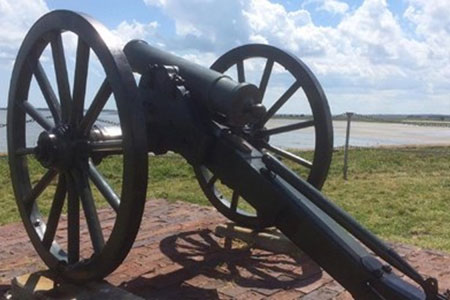
School
Learn about the battle, and see a model of how the fort appeared in 1860. This is also the primary departure point for groups wishing to visit the fort itself. Guided tours of Fort Sumter can be had on a number of topics, including Civil War cannons and artillery, and the historic flags present at the fort during the war. Visitors can also see Fort Moultrie, which was started in 1776 and modernized roughly 100 years later.
supports classroom learning in:
Social Studies.
topics covered:
American History, Civil War.
contact info
Phone: 843-883-3123
INFO
ABOUT
Fort Sumter
Fort Sumter is where the American Civil War began. Decades of growing strife between North and South erupted in civil war on April 12, 1861 when Confederate artillery opened fire on this Federal fort in Charleston Harbor. Fort Sumter surrendered 34 hours later. Union forces would try for nearly four years to take it back. Exhibits at the Visitor Education Center focus on the growing sectionalism between the North and the South, and how the conflict at Fort Sumter began the Civil War.
contact info
Hrs: Daily 8:30AM-5PM.
HELPFUL LESSON PLAN(S)
Prepared by FieldTripDirectory.com
Historic Site Lesson Plan
FUN FACTS
Philadelphia’s Independence Hall, where the Declaration of Independence and Constitution were signed; Boston’s Old State House, where the Boston Massacre and the American Revolution began; Washington D.C.’s National Mall, where Martin Luther King, Jr. delivered his “I Have a Dream” speech; Virginia’s Jamestown settlement, the country’s first colony; Charleston’s Fort Sumter, where the first shots of the Civil War were fired; New York’s Statue of Liberty and Ellis Island, where millions of immigrants were introduced to their new home. All of these sites, significant to America’s history, can be visited, toured, and admired. While visiting one of the many historical sites around the country, consider the importance in preserving these sites.
View Lesson Plan>>
Scouts
Learn about the battle, and see a model of how the fort appeared in 1860. This is also the primary departure point for groups wishing to visit the fort itself. Guided tours of Fort Sumter can be had on a number of topics, including Civil War cannons and artillery, and the historic flags present at the fort during the war. Visitors can also see Fort Moultrie, which was started in 1776 and modernized roughly 100 years later.
supports scout badges in:
Social Studies.
topics covered:
American History, Civil War.
contact info
Phone: 843-883-3123
INFO
ABOUT
Fort Sumter
Fort Sumter is where the American Civil War began. Decades of growing strife between North and South erupted in civil war on April 12, 1861 when Confederate artillery opened fire on this Federal fort in Charleston Harbor. Fort Sumter surrendered 34 hours later. Union forces would try for nearly four years to take it back. Exhibits at the Visitor Education Center focus on the growing sectionalism between the North and the South, and how the conflict at Fort Sumter began the Civil War.
contact info
Hrs: Daily 8:30AM-5PM.
HELPFUL LESSON PLAN(S)
Prepared by FieldTripDirectory.com
Historic Site Lesson Plan
FUN FACTS
Philadelphia’s Independence Hall, where the Declaration of Independence and Constitution were signed; Boston’s Old State House, where the Boston Massacre and the American Revolution began; Washington D.C.’s National Mall, where Martin Luther King, Jr. delivered his “I Have a Dream” speech; Virginia’s Jamestown settlement, the country’s first colony; Charleston’s Fort Sumter, where the first shots of the Civil War were fired; New York’s Statue of Liberty and Ellis Island, where millions of immigrants were introduced to their new home. All of these sites, significant to America’s history, can be visited, toured, and admired. While visiting one of the many historical sites around the country, consider the importance in preserving these sites.
View Lesson Plan>>
Camp
Learn about the battle, and see a model of how the fort appeared in 1860. This is also the primary departure point for groups wishing to visit the fort itself. Guided tours of Fort Sumter can be had on a number of topics, including Civil War cannons and artillery, and the historic flags present at the fort during the war. Visitors can also see Fort Moultrie, which was started in 1776 and modernized roughly 100 years later.
topics covered:
American History, Civil War.
contact info
Phone: 843-883-3123
INFO
ABOUT
Fort Sumter
Fort Sumter is where the American Civil War began. Decades of growing strife between North and South erupted in civil war on April 12, 1861 when Confederate artillery opened fire on this Federal fort in Charleston Harbor. Fort Sumter surrendered 34 hours later. Union forces would try for nearly four years to take it back. Exhibits at the Visitor Education Center focus on the growing sectionalism between the North and the South, and how the conflict at Fort Sumter began the Civil War.
contact info
Hrs: Daily 8:30AM-5PM.
HELPFUL LESSON PLAN(S)
Prepared by FieldTripDirectory.com
Historic Site Lesson Plan
FUN FACTS
Philadelphia’s Independence Hall, where the Declaration of Independence and Constitution were signed; Boston’s Old State House, where the Boston Massacre and the American Revolution began; Washington D.C.’s National Mall, where Martin Luther King, Jr. delivered his “I Have a Dream” speech; Virginia’s Jamestown settlement, the country’s first colony; Charleston’s Fort Sumter, where the first shots of the Civil War were fired; New York’s Statue of Liberty and Ellis Island, where millions of immigrants were introduced to their new home. All of these sites, significant to America’s history, can be visited, toured, and admired. While visiting one of the many historical sites around the country, consider the importance in preserving these sites.
View Lesson Plan>>
Homeschool
supports classroom learning in:
Social Studies.
topics covered:
American History, Civil War.
contact info
Phone: 843-883-3123
INFO
ABOUT
Fort Sumter
Fort Sumter is where the American Civil War began. Decades of growing strife between North and South erupted in civil war on April 12, 1861 when Confederate artillery opened fire on this Federal fort in Charleston Harbor. Fort Sumter surrendered 34 hours later. Union forces would try for nearly four years to take it back. Exhibits at the Visitor Education Center focus on the growing sectionalism between the North and the South, and how the conflict at Fort Sumter began the Civil War.
contact info
Hrs: Daily 8:30AM-5PM.
HELPFUL LESSON PLAN(S)
Prepared by FieldTripDirectory.com
Historic Site Lesson Plan
FUN FACTS
Philadelphia’s Independence Hall, where the Declaration of Independence and Constitution were signed; Boston’s Old State House, where the Boston Massacre and the American Revolution began; Washington D.C.’s National Mall, where Martin Luther King, Jr. delivered his “I Have a Dream” speech; Virginia’s Jamestown settlement, the country’s first colony; Charleston’s Fort Sumter, where the first shots of the Civil War were fired; New York’s Statue of Liberty and Ellis Island, where millions of immigrants were introduced to their new home. All of these sites, significant to America’s history, can be visited, toured, and admired. While visiting one of the many historical sites around the country, consider the importance in preserving these sites.
View Lesson Plan>>
